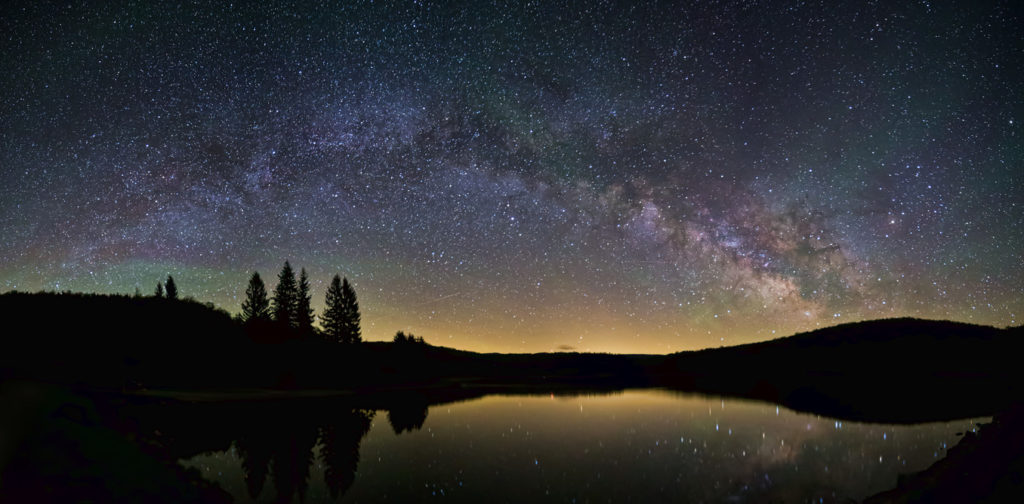After a decade of analysis and thousands of hours of observing time, we have a brand new view of the Milky Way.

The Milky Way as seen from Earth. Flickr/Peter Ozdzynski , CC BY-SA
The Milky Way as seen from Earth. Flickr/Peter Ozdzynski , CC BY-SA
Look up on any clear night and if you’re lucky you may be able to see part of the Milky Way stretching across the sky.
For many thousands of years that was all people could see of our galaxy, though today light pollution means even that view is now fading for many naked-eye observers.
Even for astronomers, much of our galaxy is obscured from view in the visible light spectrum, including the galactic centre.
Our view of the Milky Way has also come a long way since the first observation on March 25, 1951, of the famous 21-cm neutral hydrogen line by Harvard astronomers Harold Ewen and Edward Purcell.
Dutch astronomer Hendrik van de Hulst in the 1940s had provided the first prediction of the existence of this faint cosmic emission, the detection of which was to revolutionise radio astronomy.
Observations of signals at this wavelength by radio telescopes allowed the spiral structure of the Milky Way to be seen for the first time.
A clearer view
Today sees the opening of a new chapter of discovery with the release of a brand new view of the Milky Way, published in the journal Astronomy and Astrophysics.
The map stems from a decade of analysis and thousands of hours of observing time on the 64-metre CSIRO Parkes radio telescope in New South Wales, Australia, and the 100-metre Max-Planck radio telescope in Effelsberg, Germany.
The outcome is a brand new hydrogen image of the Milky Way and its environment with a level of detail that is at least four times better than previous images.

The importance of the new HI4PI image (as we call it) can be seen from the fact that the previous best but blurry image of hydrogen gas in the Milky Way, published in 2005, has so far been cited more than 1,700 times in scientific articles published in peer-reviewed journals.
Was it necessary to use observations of the whole northern and southern skies? Yes, because we live inside the Milky Way and we are entirely surrounded by it.
So the new image is a view from inside, and not an impossible view from outside.
New structure to our galaxy
By examining the motion of the hydrogen clouds towards or away from us (caused by the spin of the Milky Way), a good model of the Milky Way’s structure can be inferred.
The Australian team leader Naomi McClure-Griffiths, from the Australian National University, has already used the Parkes data to discover a new outer arm of the Milky Way.
Why did it take a decade to produce? Largely because the data not only had to be calibrated and imaged with new algorithms, but also had to be cleaned of terrestrial and cosmic noise.
Terrestrial noise comes from illegal transmissions in the 21-cm radio band. This part of the radio spectrum is protected by international treaty but we frequently detect emissions, usually caused by faulty or badly designed equipment outside (and occasionally inside) the observatories.
Cosmic noise comes from strong emissions which leak into the telescope from other parts of the sky, similar to trying to observe the night sky when there is a bright street lamp in the corner of your eye.
Fortunately, team member Peter Kalberla from the University of Bonn, Germany, was able to digitally remove these artefacts by using sophisticated models of the telescopes combined with carefully using the annual variation of the spurious signal provided by the orbit of the Earth around the Sun.
Other colleagues, including Benjamin Winkel and Juergen Kerp, were able to painstakingly crossmatch and patch together the two hemispheres into a uniform image of the Milky Way across the whole sky.
The hydrogen data from the two telescopes has already provided many scientific discoveries. The newly combined data will allow even more discoveries.
For example, we will be able to trace for the first time at this level of detail, the complete path of the stream of hydrogen being pulled from the Magellanic Clouds by the Milky Way.
The enormously strong tide created by our Milky Way has pulled out a long tail of gas from the clouds, which extends across almost the whole sky.
Just as importantly the new data set is now available to all astronomers and will provide a valuable resource for future research.
X-ray astronomers, for example, will be able to use the data to better correct their data for interstellar absorption and better understand the intense emission associated with distant supermassive black holes.
A word of warning though for those wishing to download the whole data set – it’s about 188 gigabytes. Our receivers were simultaneously tuned to thousands of different frequencies. This allowed us to look at hydrogen at many different redshifts (using the so-called Doppler effect).
So the underlying data set is vastly larger than the simple intensity and velocity images shown here! But who knows what other new discoveries the data will reveal?
![]()
Lister Staveley-Smith, Science Director at the International Centre for Radio Astronomy Research (ICRAR) and Deputy Director of the ARC Centre for All-sky Astrophysics (CAASTRO), University of Western Australia
This article was originally published on The Conversation. Read the original article.

